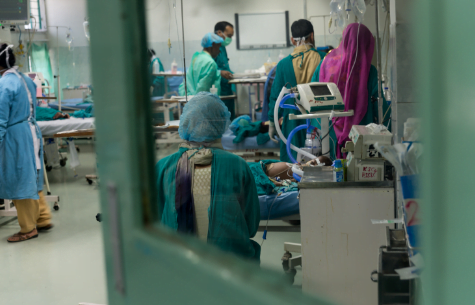MUMBAI – Abylgazy Nagmadin is a slight 28-year-old who used to work at a train station in Kazakhstan, and he has never seen his son. He’s lived at a hospital in Almaty, Kazakhstan since he was diagnosed with multiple-drug resistant tuberculosis while his wife was still pregnant. He told the World Health Organization, “the only thing I want is to get back to my family,” but because he has a disease so dangerously contagious, he must stay in quarantine.
Victims of tuberculosis, like Nagmadin, develop a wracking, often bloody cough. Caused by a bacteria and spread through respiratory fluids, other symptoms include night sweats, fever, and the devastating weight loss that gives the disease its non-scientific name – “consumption.” It’s a slow, painful way to die. Only one in ten people infected develop symptoms, so the highly infectious disease is difficult to control. While it’s incredibly prevalent – over one-thirdof the world is thought to have been infected – it’s not a very democratic disease. In 2010, most of the 8.8 million new cases of tuberculosis occurred in developing countries, leading the World Health Organization (WHO), ever tactful, to classify it as a “disease of poverty.”
Because of the severe risk of epidemics, most countries have government-mandated programs designed to detect and treat the disease, which requires a long course of antibiotics to be fully cured. Because patients begin to feel better before the course is complete, many stop taking their treatment. According to the International Journal Against Tuberculosis and Lung Disease, that’s why every year there are now 424,000 new cases of multiple drug resistant tuberculosis (MDR-TB), versions of the disease that have developed an immunity to the available treatment.
Frightening as that is, it’s an old problem, one that has been getting worse for the last ten years. What’s new is that in three different countries there’ve been rumored reports of total drug resistant tuberculosis (TDR-TB), a version of the disease that isn’t cured by anything in the medicinal arsenal.
Here’s where we veer from the field of science into the confusing intricacies of public health politics. Physicians in Italy in 2007, in Iran in 2009, and in India in 2012, have documented what some of those treating the patients call a “total” drug resistant strain. However, as with so many things in life, what you call something changes how much you fear it. And perhaps more importantly in this case, it’s a label that admits the current approach (itself the result of years of global negotiations and expensive program designs) isn’t working.
So a veritable avalanche of acronyms have been created,ranging from MDR – resistance to first-line drugs – to XDR – resistant to second-line drugs – to XXDR, before one finally arrives at TDR and the admission of defeat. This is not to make light of the importance of carefully defining the strains of the disease and what each version is resistant to. There’s a big difference between testing a drug in a lab and testing a drug on a patient in a hospital in Mumbai, even in the best-case scenarios. The susceptibility tests themselves have not been standardized, many of these cases occur in places that lack basic infrastructure and access to testing centers, and new drugs currently under development have yet to be fully explored.
But whatever you want to call it, this new strain of tuberculosis should be a cause for alarm. And it’s a problem that can’t be solved simply by adding new drugs to a failing regimen – only to have the new drugs also cease to be effective. In 2009, 193 countries signed a resolution calling for a new global approach to tuberculosis. But as of 2010, only 20 of the most affected countries on that list even had sufficient laboratories to test TB cultures.
The doctors in Mumbai who identified these highly resistant cases wrote to the Oxford Journal of Clinical Infectious Disease with a plea: India, like many other developing countries, has a largely unregulated health care system, where tuberculosis protocol isn’t always followed. Even after all the press this year of over the new strains, a study in Mumbai found that only 5 out of 106 private doctors prescribed correct medications for patients with MDR-TB. As resistance spreads beyond Mumbai – a hospital in Goa has reported additional cases this year – and possibly beyond India, it’s crucial that patients are receiving, and taking the full course, of proper treatment.
What matters is not the acronym, but that the current public health regimen isn’t working the way it should – and it’s not clear that those in charge are seeing the forest for the trees.
